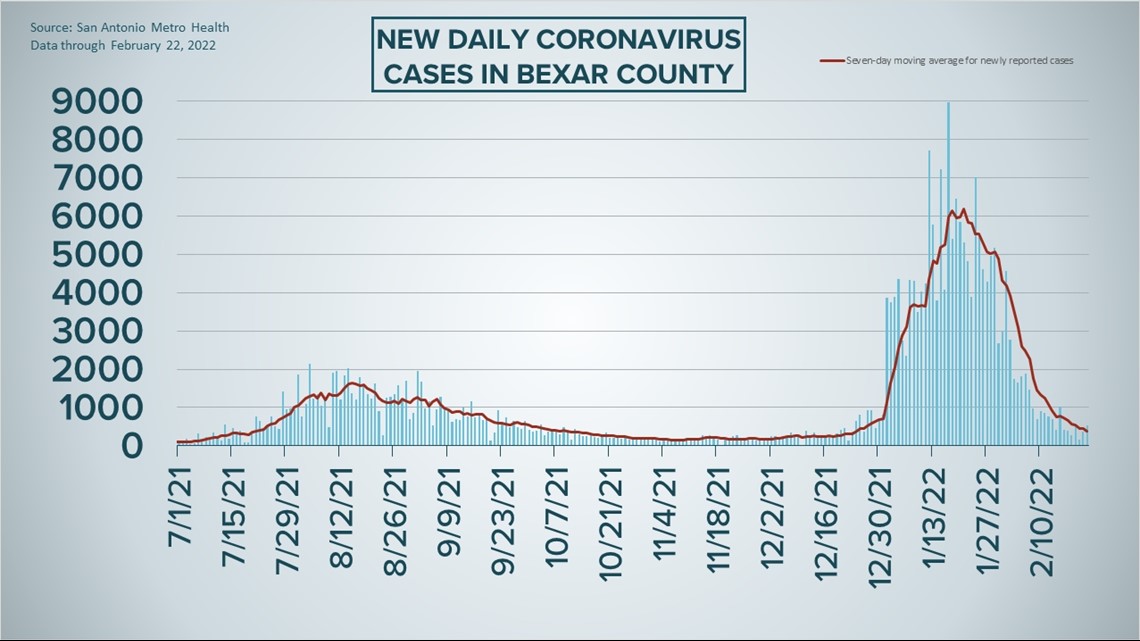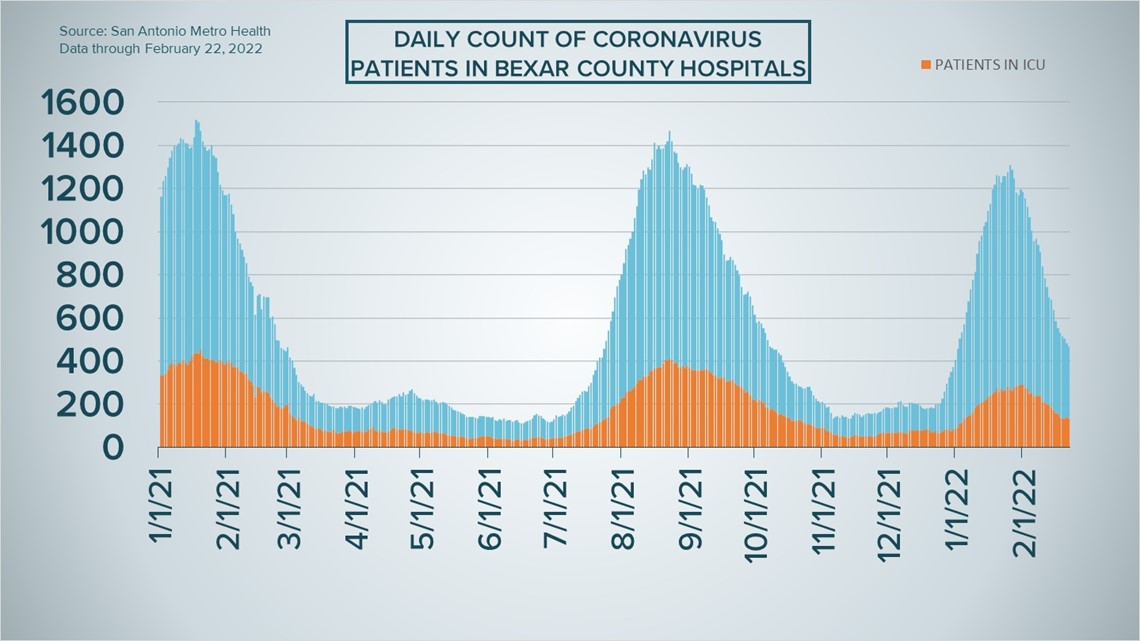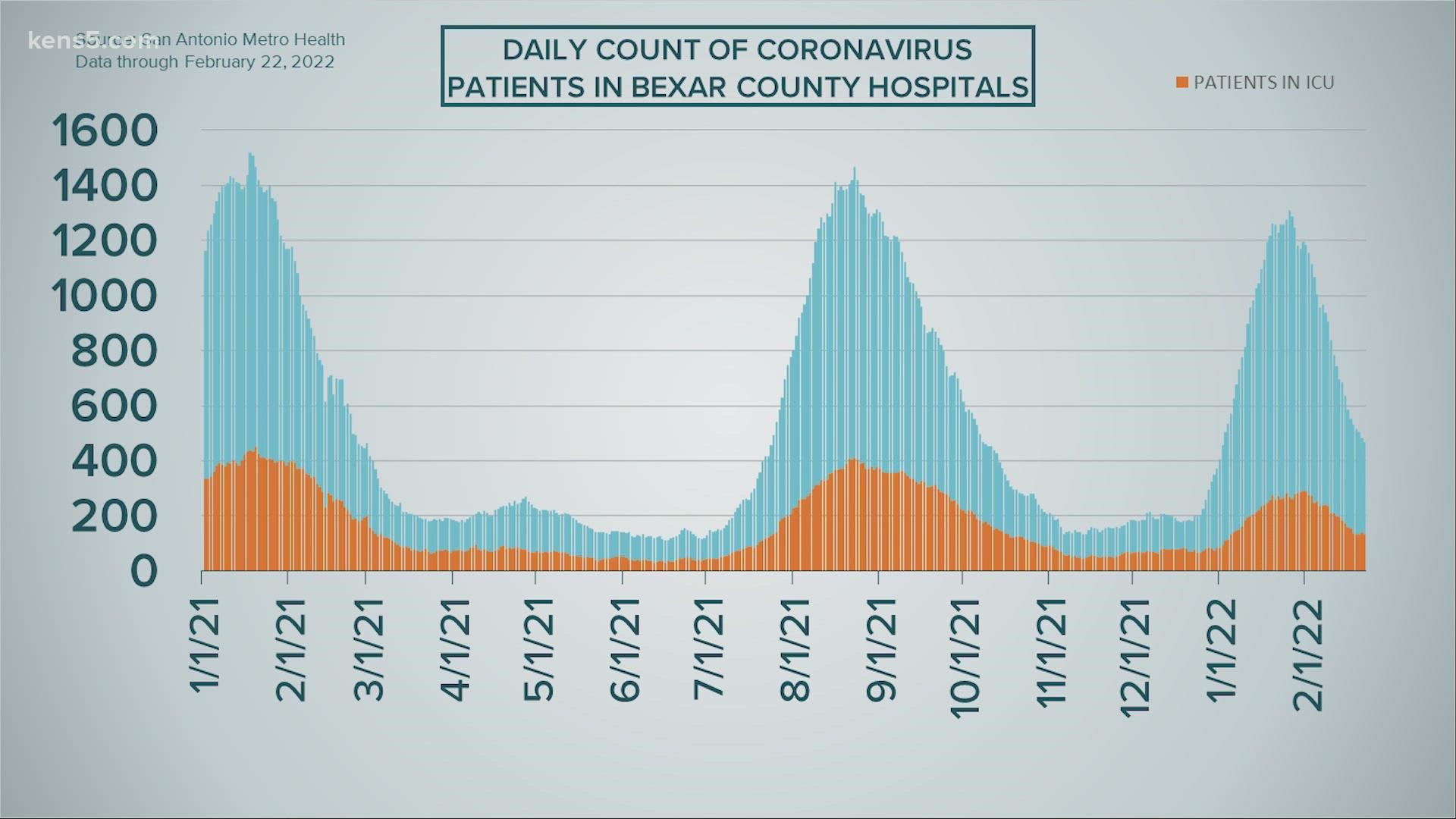SAN ANTONIO — Bexar County's COVID-19 risk level was officially downgraded to the "Moderate" threshold for the first time since the start of the year on Tuesday as the community continues to recover from its massive January spike in cases.
Metro Health reported 544 new infections, which, despite being higher than Monday's count, brought the seven-day case average down to 385, a new record-low for 2022 in the county. The positivity rate also dropped to below 10% for the first time all year; it now stands at 9.7%.
Hospitalizations, meanwhile, also dropped for a 15th straight day. On Tuesday there were 469 patients receiving treatment for COVID-19 in local hospitals; the number has dropped by 26% over the last week.
Of those 469 patients, 132 are in intensive care and 65 are using ventilators.
Three additional virus-related fatalities were also reported by Metro Health on Tuesday. A total of 5,234 Bexar County residents have died from COVID-19 complications, while more than 521,000 have been diagnosed.
Community Labs announced it was closing some San Antonio COVID-19 testing sites as demand goes down. Three will remain open for the time being during the week.
How Bexar County is trending




Vaccine Progress in Bexar County
The following numbers are provided by San Antonio Metro Health. A full breakdown can be found here.
- 1.743 million eligible Bexar County residents have received at least one dose of the coronavirus vaccine as of Thursday, Feb. 17.
- 1.42 million eligible Bexar County residents are fully vaccinated as of Thursday, Feb. 17.
The CDC states that "when a high percentage of the community is immune to a disease (through vaccination and/or prior illness)," that community will have reached herd immunity, "making the spread of this disease from person to person unlikely."
The City of San Antonio breaks down the vaccination rates by zip code on Metro Health's Vaccination Statistics page.
Coronavirus in Texas
The total number of coronavirus cases in the state since the pandemic began grew by 5,858 on Tuesday, according to the Texas Department of State Health Services. That total includes 4,084 new confirmed cases and 1,774 new probable cases. More details can be found on this page.
Tuesday's figures bring the total number of Texans diagnosed with COVID-19 to more than 6.523 million.
An additional 192 Texans have died from virus complications, meanwhile, raising the statewide death toll to 82,627.
Coronavirus symptoms
The symptoms of coronavirus can be similar to the flu or a bad cold. Symptoms include fever or chills, cough, shortness of breath or difficulty breathing, fatigue, muscle or body aches, headache, new loss of taste or smell sore throat, congestion or runny nose, nausea or vomiting, and diarrhea, according to the Centers for Disease Control.
Most healthy people will have mild symptoms. A study of more than 72,000 patients by the Centers for Disease Control in China showed 80 percent of the cases there were mild.
But infections can cause pneumonia, severe acute respiratory syndrome, kidney failure, and even death, according to the World Health Organization. Older people with underlying health conditions are most at risk.
Experts determined there was consistent evidence these conditions increase a person's risk, regardless of age:
- Chronic kidney disease
- COPD (chronic obstructive pulmonary disease)
- Obesity (BMI of 30 or higher)
- Immunocompromised state (weakened immune system) from solid organ transplant
- Serious heart conditions, such as heart failure, coronary artery disease, or cardiomyopathies
- Sickle cell disease
- Type 2 diabetes
- The CDC believes symptoms may appear anywhere from two to 14 days after being exposed.
Human coronaviruses are usually spread...
- Between people who are in close contact with one another (within about 6 feet).
- Through respiratory droplets produced when an infected person coughs, sneezes or talks. These droplets can land in the mouths or noses of people who are nearby or possibly be inhaled into the lungs.
- Some recent studies have suggested that COVID-19 may be spread by people who are not showing symptoms.
Help stop the spread of coronavirus
- Stay home when you are sick.
- Eat and sleep separately from your family members
- Use different utensils and dishes
- Cover your cough or sneeze with your arm, not your hand.
- If you use a tissue, throw it in the trash.
Find a Testing Location
City officials recommend getting a COVID-19 test if you experience fever or chills, cough, shortness of breath or difficulty breathing, fatigue, muscle or body aches, headache, new loss of taste or smell, sore throat, congestion or runny nose, nausea or vomiting, or diarrhea.
Here's a Testing Sites Locator to help you find the testing location closest to you in San Antonio.
Latest Coronavirus Headlines
- Round Rock ISD now says masks 'strongly recommended' and visitors allowed
- Boris Johnson scraps remaining COVID restrictions in England
- Texas sues CDC to stop mask mandates on planes
- The connection between COVID and Chronic Fatigue Syndrome
- Queen still has mild COVID symptoms, cancels online meetings
- Carnival Cruise Lines to drop mask mandate for passengers

